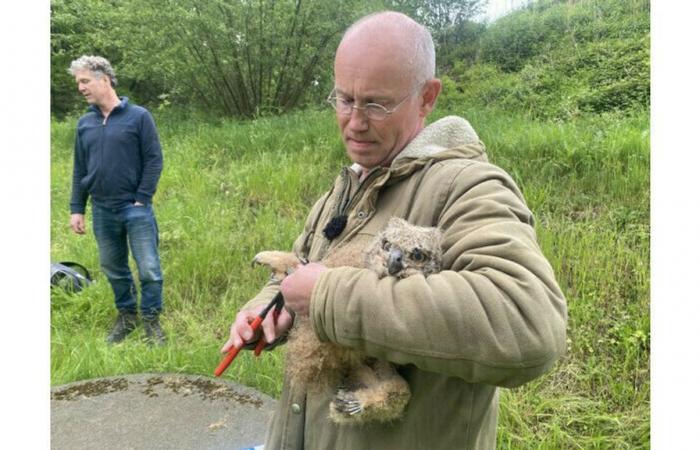NOS News•today, 1:00 PM
More and more eagle owls are arriving in the Netherlands. Since the turn of the century, the owl species has been on a steady rise. “Until 2001, a nesting pair was occasionally found, but now we may already have more than a hundred,” says Gejo Wassink of Oehoewerkgroep Nederland.
He is on his way to provide four young eagle owls with a ring. These chicks were born on the site of waste processor Twence in Hengelo, where a pair of eagle owls have been staying for thirteen years. During those years, 42 offspring were produced.
The arrival of the eagle owls in the Netherlands is thanks to Germany: a successful reintroduction has taken place there and the owls are no longer hunted. Since then, they have continued to expand their habitat and have therefore come to us. The eastern provinces were the first to be affected.
Formidable hunter
They are now four weeks old and that is the age at which they are banded. Armed with a large yellow shopping bag, members of the ring team climb an extension ladder to the nest: a rectangular wooden box placed in a tree especially for the eagle owls. There they can go about their business in peace, while large machines are busy separating waste further on the site.
One by one the chicks come out of the bag. With pliers, Wassink applies a metal ring to the already sturdy legs of the young bird. The long curved nails show that this will be a formidable hunter.
The animals are ringed and weighed:
Endangered eagle owl appears to be making a comeback
The eagle owl is the largest owl species in Europe. An adult bird can grow to a height of 70 centimeters and have a wingspan of up to 180 centimeters. The female grows largest and can carry prey weighing up to three kilos.
Rats are the main food at this former landfill, but young hares and rabbits also pass by occasionally. Or a pigeon or a crow. Eagle owls are not picky. It therefore seems likely to Wassink that they will also settle elsewhere in the Netherlands.
“Take the Flevopolders, there they are teeming with geese and water birds. I don’t know why he wouldn’t feel at home there.” Maybe that will be the new territory of one of these four little ones.
Now they are still covered in down and pathetically helpless, but from September they will have to fend for themselves. Until then, they are still fed by their parents and given hunting lessons.
Stars in their own soap opera
There are also threats that can slow population growth. “Traffic in particular causes casualties. And barbed wire. An eagle owl has incredibly good eyes, but if it chases a hare with full focus, it does not see it and gets stuck in it. Here in Twente, barbed wire has been replaced by other fencing and that helps.”
So the eagle owl is doing well, but a little attention can’t hurt. The four documented and ringed chicks are put back in the bag and returned to the nest. And now they are the stars in their own soap again: in the images of Experience the Spring you see them snuggled up together, waiting for father to fly in with a lovely fat rat.







